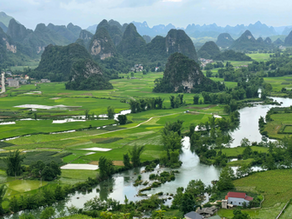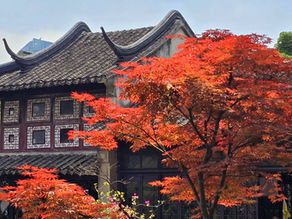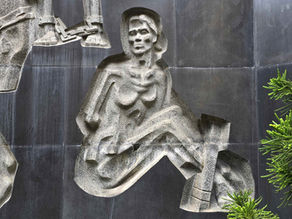top of page

GLOBAL SHANANIGANS

Search


Yangshuo County - A Journey Through History and Hills
Tucked deep within Guangxi’s dramatic karst terrain, Yangshuo's landscape is far more than a picturesque backdrop, it is steeped in spiritual and supernatural significance. For centuries, locals have believed the towering limestone peaks to be the resting places of ancient spirits, with many formations given mythological names and stories. One of the most iconic is Moon Hill, named for its crescent shaped cave, which legend says was created by a celestial blade slicing throug
Shannon


The Forgotten History of Đồng Văn
Nestled high in the Dong Van Karst Plateau of Ha Giang Province, Đồng Văn Ancient Town carries within its narrow stone-paved streets a haunting blend of history, war and legend. This remote outpost near the Chinese border has long served as a cultural and military crossroads. The town itself is over a century old, with well-preserved architecture reflecting a fusion of Vietnamese, Chinese and French colonial influences.
Shannon


Moana Cafe
Moana Café is one of Sapa’s most visually striking and unconventional destinations, located just a short walk from the town centre. Perched on a gentle hillside overlooking the Hoàng Liên Sơn mountain range, the café offers more than just coffee, it’s a curated outdoor experience designed to immerse visitors in panoramic views and imaginative, art-inspired spaces. This makes it especially popular among local tourists and Instagram-savvy travellers.
Shannon


Carved in Time - Khuổi Ky Stone Village
Known for its striking stone architecture and deeply rooted cultural traditions, Khuổi Ky’s origins trace back over 400 years and was established by the ancient Tay ethnic tribe, after 2,000 years of hardship and migration from the southern regions of China and Cambodia. The Tay people, one of Vietnam’s oldest and most culturally rich ethnic groups, are believed to have journeyed across generations, seeking fertile land and spiritual sanctuary.
Shannon


The Lingering Garden
In a city celebrated for its canals, silk and scholars, Suzhou’s Lingering Garden represents a pinnacle of classical Chinese garden design. Often referred to as one of the “Four Great Classical Gardens of China,” it embodies centuries of artistic refinement and philosophical thought. Built in 1593 during the Ming dynasty by Xu Taishi, a high-ranking official who sought retirement and tranquility, the garden stands as a personal reflection of his scholarly ideals.
Shannon


Ô Quy Hồ Heavens Gate
Often bound in heavy fog, Cổng Trời Ô Quy Hồ or Heavens Gate, is a lesser known temple complex and viewpoint, situated atop the Ô Quy Hồ Pass, one of Vietnam's most majestic mountain passes. Located approximately 18 km's from Sapa town, this pass connects the provinces of Lào Cai and Lai Châu. Perched at an elevation of 2035 metres, it offers visitors panoramic vistas of the Hoàng Liên Sơn mountain range, including glimpses of Fansipan, the highest peak in Indochina.
Shannon


Seven Star Park of the Immortals
Seven Star Park, located on the eastern side of Guilin, Guangxi, derives its name from the formation of seven limestone peaks arranged in the shape of the Big Dipper constellation. This celestial reference is not only a poetic nod to the stars but also deeply symbolic in Chinese cosmology, where the Big Dipper is associated with divine guidance, fate and protection.
Shannon


The Myth and Majesty of Fansipan Mountain
Perched 3143 metres above sea level, Fansipan towers over the stunning Hoàng Liên Son mountain range & national park in northern Vietnam. Often called the “Roof of Indochina,” it is the highest point in the country and the broader Indochinese Peninsula. Yet its significance transcends far beyond altitude. Among the swirling clouds and ancient forest paths, Fansipan is a mountain shrouded in ancestral reverence, layered with wartime memories and wrapped in folklore.
Shannon


Bạch Mã Temple
Bạch Mã Temple, the oldest temple in Hanoi’s Old Quarter, traces its origins back to the year 1010, during the reign of Emperor Lý Thái Tổ. It is one of four sacred temples in the city, constructed to stand as a spiritual guardian for the eastern side of ancient Thang Long (modern-day Hanoi) and was carefully chosen according to the principles of geomancy and the cardinal points.
Shannon


Love Waterfall and the Fairy’s Curse
Located about 13km's down a winding alpine road from Sa Pa town, the majestic Silver Waterfall thunders 200 metres down the cliffs of the Hoàng Liên Son Mountains from the headwaters of the Lo Sui Tong peak. Known to locals as "Thác Bạc" the falls are fed by glacial runoff that originate near the summit of Fansipan, the highest peak and "Roof of Indochina"
Shannon


Hỏa Lò Prison
Constructed by the French in 1896 as part of their broader strategy to subjugate Vietnam under colonial rule, Hỏa Lò Prison was built to break the will of Vietnamese revolutionaries and political dissidents. Intended to hold 450 inmates, it regularly crammed in over 2000, locking men and women into rotting, airless cells that stank of urine, sweat and blood. It became a crucible of suffering, where countless resistance leaders endured torture, starvation and isolation.
Shannon


Bản Giốc Waterfalls
Carved by the Quây Sơn River, this magnificent tiered waterfall spans about 300 metres in width and cascades down 30 meters, making it the largest natural falls in Southeast Asia and the fourth largest transboundary waterfall in the world. Located on a remote border between Vietnam’s Cao Bằng Province and China’s Guangxi region, the Bản Giốc Waterfall (known as the Detian Falls in China) is one of Asia’s most spectacular natural wonders, rivalling Plitvice in Croatia.
Shannon


Bridge Between Worlds - Ngọc Sơn Temple
Tucked away on a small jade-green islet in the heart of Hanoi’s Hoàn Kiếm Lake, Ngọc Sơn Temple (“Temple of the Jade Mountain”) is a portal into Vietnam’s tangled history of war, mysticism, and legend. Ngọc Sơn Temple rose in 1841 to honour the national hero General Trần Hưng Đạo, who crushed Mongol invaders in the 13th century, and its story is woven tightly with both fact and fascinating folklore.
Shannon


Through the Mist of Thác Bạc - The Silver Waterfall of Sa Pa
Located about 13km's down a winding alpine road from Sa Pa town, the majestic Silver Waterfall thunders 200 metres down the cliffs of the Hoàng Liên Son Mountains from the headwaters of the Lo Sui Tong peak. Known to locals as "Thác Bạc" the falls are fed by glacial runoff that originate near the summit of Fansipan, the highest peak and "Roof of Indochina"
Shannon


The Temple of the Dog
Thủy Trung Tiên Temple, once known as Cẩu Nhi Temple, rests on a quiet, tree-lined island on Trúc Bạch Lake, just north of Hanoi’s West Lake. Modest in size but heavy with history, the temple dates back over 1000 years and is one of the capital’s oldest surviving spiritual sites. Few visitors realise it’s built on the remnants of a forgotten cult, one centred on the worship of a dog.
Shannon


H’Mong King Palace - Fortress of the Opium King
Deep within the misty limestone mountains of Vietnam’s northern highlands, the H’Mong Kings' Palace stands as a solemn relic of power, ambition & tribal legacy. Also known as the Vuong Family Mansion (Dinh Vua Mèo), construction commenced in 1898 under the directive of H’Mong leader Vương Chính Đức, a powerful warlord and opium King.
Shannon


The Legacy of Trấn Quốc Pagoda
With its origins stretching back over 1500 years, Trấn Quốc Pagoda holds the distinction of being the oldest Buddhist temple in the country. It was originally built around 545 AD during the reign of Emperor Lý Nam Đế, who commissioned its construction as part of a broader vision to legitimise Vietnamese sovereignty in the midst of political upheaval and resistance against Chinese rule.
Shannon


Trúc Lâm Phật Tích Bản Giốc Pagoda
Perched on the forested slopes of Phia Nham Mountain in northern Vietnam’s Cao Bằng Province, this pagoda complex is a spiritual beacon overlooking the breathtaking Bản Giốc Waterfall. Officially inaugurated in December 2014, the pagoda holds the distinction of being the first Buddhist temple built along the northern border of Vietnam.
Shannon


The Legacy of King Lê Thái Tổ
This quiet and understated shrine on the southeastern banks of Hoàn Kiếm Lake pays homage to King Lê Thái Tổ, the revered 15th-century General-turned-Emperor. He liberated Vietnam from Chinese rule and founded the Later Lê Dynasty, the country's longest ruling imperial line. Built in 1894, the Lê King Temple is a quiet portal into Vietnam’s post-colonial rebirth, layered with political significance and tales of divine destiny, rebellion and the enduring power of myth.
Shannon


Beneath the Dragon - Imperial Citadel of Thăng Long
Constructed on the remains of a 7th century Chinese fortress, the Thăng Long Imperial Citadel was built on strategic reclaimed river lands on the lower Red River Delta and for nearly 13 centuries, remained the regional powerhouse of Northern Vietnamese political & military domination. Shortly after his ascension to the throne, Emperor Lý Thái Tổ declared a royal decree in the year 1010, to move the capital from Hoa Lư and establish a new Imperial City for the Lý Dynasty.
Shannon
bottom of page